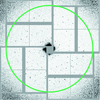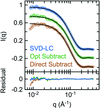issue contents
August 2015 issue

Cover illustration: Laue diffraction image of a protein crystal recorded on the MaNDi instrument. Courtesy of Coates et al. [J. Appl. Cryst. (2015), 48, 1302–1306].
feature articles
`Quasi-mosaicity' is an effect of anisotropy in crystals, which permits one to obtain two curvatures in two perpendicular crystallographic planes. A comprehensive survey of the physical properties and the applications of `quasi-mosaicity' are extensively reported.
research papers
Digital image analysis methods are developed to measure the strain in helium-implanted polycrystals, from X-ray Laue patterns. Badly detected spots, fitting errors and low-accuracy results are automatically detected and eliminated using statistical tools based on least-squares fitting.
A rapid nondestructive defect assessment and quantification method based on X-ray diffraction and three-dimensional reciprocal-space mapping has been established.
Detection of medium-range-order structure in amorphous germanium films by spectroscopic ellipsometry
Amorphous germanium (a-Ge) films in the thickness range of 5.2–370.7 nm were prepared by radio frequency magnetron sputtering. Spectroscopic ellipsometry analysis shows that less than 3% of medium-range order exists in a-Ge under the reported deposition conditions.
This paper proposes a simple three-dimensional structural evaluation system for a film during uniaxial deformation. The two-dimensional patterns of small-angle X-ray scattering and wide-angle X-ray diffraction at the so-called edge and end views, and stress–strain data, can be obtained via this system during film stretching.
The conformal roughness turns nonconformal with stress relaxation by increasing the substrate bias voltage within Fe/Si multilayers, while the magnetic domain correlations always remain nonconformal. Lower diffuse intensity and sharper reflectivity make the stress-free sample more suitable as a supermirror.
Time-resolved (four-dimensional) and high-resolution data have been collected using X-ray diffraction contrast tomography (DCT) and the TriBeam from the same volume in a single strontium titanate sample. Methods presented for the merger of the reconstructions enable direct quantitative comparisons on a grain and voxel scale and can be extended to other multi-modal data sets.
An investigation of adhesive–adherent interfaces probed with grazing-incidence small-angle neutron scattering is described.
Open  access
access
 access
accessThe paper describes quantitative methods for determining the background scattering from materials, including gases, liquids and solids, found in small-angle neutron scattering measurements. By understanding the dependence of the background on material type, thickness, wavelength and temperature, the investigator can design experiments that minimize the background scattering and thus improve the statistical accuracy of the background-corrected data.
This paper presents a suite of support devices for fixed-target sample delivery to X-ray free-electron laser sources, and demonstrates X-ray diffraction from two- and three-dimensional crystals adhered to these supports.
Eleven permissible types of domain walls are predicted to exist theoretically in ferroelectric Bi4Ti3O12 according to group-theory analysis. Among them, just the five types of ferroelectric domain walls were observed in Bi4Ti3O12 single crystals using transmission electron microscopy.
The straightforward calculation of the intensity of small-angle X-ray scattering by spheres at different concentrations has shown that using the Guinier plot to find the radius of gyration of spheres underestimates it noticeably at a volume concentration of particles of ∼1% and higher.
A modified three-dimensional X-ray diffraction (3DXRD) technique is proposed as a solution to the main problem with 3DXRD-type experiments, namely, polycrystalline diffraction spot overlap.
Methods were developed to facilitate analysis of size-exclusion chromatography–small-angle X-ray scattering experiments by singular value decomposition and improve reconstruction of protein scattering by Guinier-optimized linear combination with or without buffer subtraction.
The resonance effect in the X-ray magnetic diffraction from the ferromagnetic intermetallic compound GdAl2 is studied by a white-beam experiment and theoretical analysis.
Open  access
access
 access
accessA methodology is presented to compute diffuse scattering arising from one-phonon excitations in a time-of-flight neutron single-crystal Laue diffraction experiment from density functional theory results. This methodology is illustrated using NaCl as an example.
Open  access
access
 access
accessDetails are described of the calculation of new parallelity restraints recently introduced in cctbx and PHENIX.
Neutron diffraction methods together with structure factor calculations have been applied to determine the microscopic magnetic configuration of Fe50Pt50−xRhx films as a function of temperature and Rh concentration.
The diffraction properties of phase gratings fabricated on an Si(111) crystal were studied by triple-axis X-ray diffraction. It is shown that the presence of a grating as a phase-shift W layer on the crystal surface causes the formation of a complicated two-dimensional diffraction pattern.
Near-field high-energy X-ray diffraction microscopy has been used to characterize the three-dimensional crystallographic orientation field of the hexagonal close-packed α phase in a bulk Ti–6Al–4V specimen with a lamellar (β-annealed) microstructure. A three-dimensional Burgers orientation relationship-based flood-fill algorithm has been implemented to reconstruct the morphologies and crystallographic orientations of the high-temperature body-centered cubic prior-β grains.
Powder diffraction theory is extended on the basis of the decoupling approximation for the small-angle scattering of crystalline assemblies composed of multiple types of spherical or polyhedral particles. Methods to overcome the limitation of the decoupling approximation are discussed. Additionally, the total scattering intensity for an assembly of finite size is presented.
An in situ neutron diffraction technique was used for exploring the deformation behavior in an Ni43Fe18Ga27Co12 alloy with strain glass state to reveal the new intrinsic physical nature of quasi-linear superelasticity.
The paper describes a new furnace design for high-temperature single-crystal X-ray diffraction measurements that significantly improves performance and addresses issues associated with previous designs.
A Bayesian statistics method accounting for effects of systematic errors in Rietveld refinements is introduced. The procedure has been implemented as an extension to the software package GSAS-II.
Individual crystallites contribute multiple beams to diffraction spectra from nanocrystalline powders. This complicates correlating the number of diffracting grains with diffracted intensities.
Contrast rosettes observed at the site of edge dislocations revealed in X-ray topography based on the Borrmann effect have been studied. Using modifications of equations for contrast to account for the local lattice deformations around edge dislocations, simulated images of such rosettes have been constructed. They show good agreement with experimentally obtained images of edge dislocations in ZnGeP2
Three in situ X-ray diffraction sample environments for gas–solid and gas–solid–liquid reactions at elevated pressure and temperature are described. The environments can be used in a wide range of fields and can withstand up to 1000 bar (1 bar = 105 Pa).
The design and experimental realization of a multislit very small angle (VSANS) instrument which will operate in the time-of-flight mode encountered at spallation sources is presented. This device enables access to a smaller wavevector transfer with larger intensities in SANS experiments, allowing faster measurements. The possibility of making this kind of instrument scalable to access varying minimum wavevector transfer in scattering experiments is also shown.
Assisted by detailed crystallographic analysis, the mechanisms for the ultrahigh fracture strength of cemented carbides are disclosed.
teaching and education
Free 

CRISTALES: a world to discover is a teaching/outreach exhibition for schools and universities, offering a groundbreaking view of crystallography and its main contributions to society.
Free 

Crystallography is little known to the public, even though it underpins much of the research into matter in physics, chemistry, new materials and life sciences. This article describes the travelling exhibition Journey into the crystal, which presents to the general public the science and the beauty of matter in the crystalline state with a flavour of crystallography.
Free 

A critical revision of fundamental crystallographic concepts and the pedagogical approaches used to introduce them is presented.
short communications
Download citation


Download citation


The crystal and molecular structure of ebastine has been determined, employing the technique of single-crystal X-ray diffraction. The piperidine ring in the ebastine molecule was found to exist in a chair conformation.
CCDC reference: 956068
After several years in construction and commissioning the Macromolecular Neutron Diffractometer (MaNDi) is now operational and accepting general user proposals.
computer programs
Multifit/Polydefix is an open source IDL software package designed to make the tedious data analysis of synchrotron-based plasticity, rheology or other time-dependent experiments very straightforward and accessible to a wider community.
Open  access
access
 access
accessTEMPy is an object-oriented Python library that provides the means to validate density fits in electron microscopy reconstructions. This article highlights several features of particular interest for this purpose and includes some customized examples.
Open  access
access
 access
accessBINoculars is a tool for data reduction and analysis of large sets of surface diffraction data that have been acquired with a two-dimensional X-ray detector.
OrientXplot is a Windows program to manipulate and display relative orientation data of pairs of single crystals, allowing for the symmetry of both crystals.
Open  access
access
 access
accessUsing a newly created open-source tool Xtal-xplore-R some universal features of the crystallographic residual function have been found, which might help in developing new algorithms suitable for crystal structure solution.
laboratory notes
Open  access
access
 access
accessApparatus is described for the purpose of automated grain mapping of polycrystalline samples within a laboratory environment, using a motorized sample stage and a CCD detector. The limitations that come from using a faster detector of relatively small surface are countered using an automated translation stage.

 journal menu
journal menu




























































